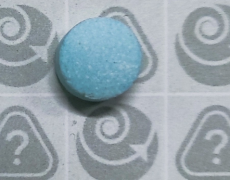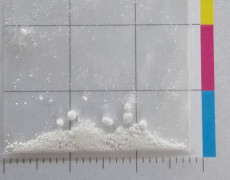Highly potent synthetic opioid misrepresented as butonitazene
-
Notification
-
Opioids
-
- Nationwide
More highly potent nitazene variations have been identified.

How to identify the drug
- Orange powder
- Sold as butonitazene
This notification is to let you know that a highly potent synthetic opioid has been misrepresented as butonitazene. A sample of this substance was submitted to the Institute of Environmental Science and Research (ESR) for analysis, which determined the sample contained either N-pyrrolidino-protonitazene or N-pyrrolidino-isotonitazene.
Although these all come from the nitazene class of drugs and produce similar effects, N-pyrrolidino-protonitazene and N-pyrrolidino-isotonitazene are significantly more potent than butonitazene. People consuming this substance believing it to be butonitazene are at significant risk of harm, including death.
The substance was detected in an orange powder in Wellington and is possibly in circulation nationwide.
High Alert urges extreme caution should you choose to take orange powders. Consumption of this powder could lead to serious harm, including death, even if you have experience using opioids.
If you or someone you know take this substance and start to lose consciousness or breathe slowly, call 111 immediately. Tell them what you think has been taken and that it could be an opioid overdose.
Naloxone can be used to help reverse an opioid overdose. Given the potency and duration of effect, any person administered naloxone should continue to be monitored for at least 2 hours and followed up by medical services.
Drug checking is recommended to help minimise the risk. KnowYourStuffNZ, the NZ Drug Foundation and NZ Needle Exchange Programme run drug checking clinics across the country to help reduce harm - check the schedule here. It's free, legal and confidential.
If you have heard of any reports of this drug, please let us know! The alert ID is N22/0038. All submissions are anonymous.
How to recognise the drug
As seen in the image, the substance presented for drug checking is an orange powder. This powder was sold as butonitazene. Nitazene compounds are increasingly available in New Zealand and can come in a variety of forms including pills, powders, gel caps and liquids. Fentanyl test strips cannot be used to detect nitazenes.
N-pyrrolidino-protonitazene and N-pyrrolidino-isotonitazene come from a class of drugs known as nitazenes. Nitazenes are highly potent synthetic opioids, and may have been linked to several deaths in New Zealand. There is no way to accurately dose these substances, and injecting has increased risk. N-pyrrolidino-protonitazene has been implicated in many deaths internationally, with pharmacological data suggesting it exhibits potency of 25 times greater than fentanyl.
The effects of N-pyrrolidino-protonitazene, and N-pyrrolidino-isotonitazene are likely similar to other synthetic opioids. These effects include:
- Feeling euphoric or in a ‘dreamlike’ state.
- Sedation (‘the nod’ – being drowsy and then jerking awake).
- Temporary relief of pain, stress, or low mood.
- Severe nausea and/or vomiting.
- Severe sweating or fever.
- Slowed and/or difficulty breathing.
- Blue lips and/or fingertips.
- Cold and clammy skin.
- Pinpoint (tiny) pupils.
- Becoming unresponsive and/or losing consciousness.
How to reduce harm from the drug
N-pyrrolidino-protonitazene and N-pyrrolidino-isotonitazene are very strong opioids and consumption can easily lead to an overdose, even among people with experience using opioids. High Alert urges extreme caution should you choose to use orange powders.
If you choose to use this substance:
- Avoid using alone. Have a buddy who can help, and call an ambulance, if things go wrong.
- Start off with a smaller or ‘tester’ dose to check how it affects you. In general, swallowing a substance has a slower onset than other methods and means there might be more time to get medical help if needed. Remember, the quantity of active ingredients in tablets and powders can be very different. Don’t assume you will experience the same effects each time.
- Avoid using it at the same time as other substances, especially other depressant drugs such as alcohol, opioids, GHB/GBL, ketamine, and benzodiazepines, as these can increase the sedative effects of opioids (for example, slowing or stopping breathing).
- Have naloxone with you – a drug that can temporarily reverse the effects of an opioid overdose and give you more time to get medical help. Talk to your GP about this. Some pharmacies and needle exchanges stock naloxone and the Nyxoid nasal spray can also be purchased direct from the ‘Pharmaco Emergency Care’ website. High potency opioids like N-pyrrolidino-protonitazene, and N-pyrrolidino-isotonitazene may require more than one dose of naloxone. Remember, nitazenes can be fast acting and you may not initially realise you require naloxone. Even if you have naloxone on hand, you may not be able to administer it by yourself. Avoid using substances which might be nitazenes when alone. Have someone with you who is familiar with and can administer naloxone if needed.
- Drug checking is recommended to help minimise the risk. KnowYourStuffNZ, the New Zealand Drug Foundation and the New Zealand Needle Exchange Programme are running regular drug checking clinics. Information on upcoming clinics, including those coming up in the Wellington region, can be found on The Level.
Call 111 and ask for an ambulance immediately if you or someone else has any of the below signs after taking this substance. Tell them what has been taken and that it could be an opioid, it could save a life. Don’t leave the person alone and treat it as an overdose if unsure.
The signs of an opioid overdose include:
- The person's face is extremely pale and/or feels clammy to the touch.
- Their body goes limp.
- Their fingernails and/or lips have a purple or blue colour.
- They start vomiting or making gurgling noises.
- They cannot be awakened or are unable to speak.
- Their pupils become very small.
- Their breathing and/or heartbeat slows or stops.
If you have heard of any reports of this drug, please let us know through the Report unusual effects page, the alert ID is N23/038. All submissions are anonymous.
Stay safer by staying informed. Sign up to receive alerts and notifications about any dangerous drugs in NZ. Check out the alerts page to see what we've already found.
The National Poisons Centre is available 24/7 to help members of the public and healthcare professionals with clinical advice for exposures to this, or any other substance - please call 0800 764 766 (0800 POISON).
Are you concerned about your own drinking or drug taking? Reach out to the Alcohol Drug Helpline on 0800 787 797, or text 8681. You'll be able to speak with a trained counsellor who can provide you with helpful information, insight and support. They’re available 24/7, all calls are free and confidential.
You can also chat to the Alcohol Drug Helpline team online through the website, or:
- Call the Māori Line on 0800 787 798 for advice and referral to kaupapa Māori services.
- Call the Pasifika Line on 0800 787 799 for advice and referral to services developed for Pacific people.
- Call the Youth Line on 0800 787 984 for advice and referral to services for young people.
Latest Alerts & Notifications

Highly potent synthetic opioid detected in fake diazepam tablet

Alpha-PVP like substance misrepresented as MDMA in Christchurch

Heroin sold as ketamine in Auckland region

Highly potent synthetic opioid misrepresented as butonitazene

